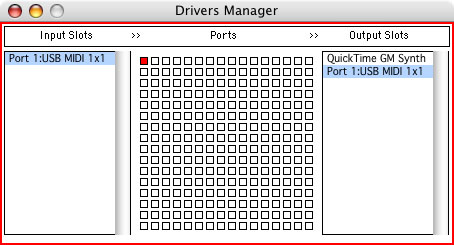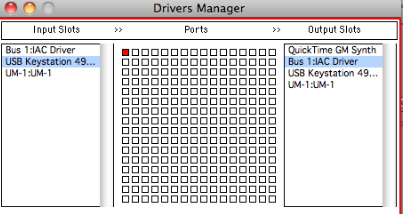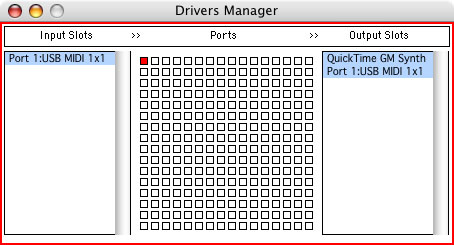Note, if you have already setup other Wires.Under.Tension software instruments you will still have to ensure MidiShare is set-up to output Midi (and connect your controller's Midi input to your interface's output if using Midi cable connections) as this is atypical of a Wires.Under.Tension application.
Below is a quick explanation of how to set-up MidiShare with your Midi device. Please refer to the MidiShare documentation if you encounter any difficulties setting up your controller with MidiShare.
MAC: The MidiShare folder should be at
WINDOWS: MidiShare applications are in the Moop folder at
Never move the Moop application out of its folder or it won't run. Move the entire folder with all its subfolders intact if you want to relocate the program.
Connect your Midi device to your computer, installing any needed driver software.
If your keyboard controller is also the sampler that will be used to playback sounds triggered by Moop's loops then make sure your device is connected in both directions:
For example, from your controller's Midi output to your Midi interface and from your interface back to you your controller's Midi input.
Open the msDrivers application (in the MidiShare folder on a Mac or the Moop folder on Windows)
Your Midi device should show up in the "input slot" column on the left side column. If not, your computer doesn't recognize your Midi device at all and very likely the drivers for the device aren't installed or your device isn't actually connected to your computer.
The middle area of the msDrivers application contains a grid of squares that represent MidiShare ports.
Click on the most upper-left square, Port 0, making the port turn red indicating it is in editing mode.
While in editing mode, select your Midi device from the left side "input slot" column. This maps your input device to Port 0.
The output device you pick from the right side will determine where the midi output of Moop goes.
If your midi device is also a sampler that will play the samples using Moop's loops, while still in editing mode, select your midi device from the left side "output slot" column. This maps your output device to Port 0.
If you are using another audio application to playback the sounds (e.g. Ableton Live), first turn on, and then select your inter-application Midi driver (Mac: IAC Driver, Windows: install/use Midi Yoke) as the output destination. Then setup your audio application to receive Midi data from this driver. E.g. in Ableton Live, create a Midi track that receives from "All Ins" and put your desired Midi device on that track. Make sure to enable both your inter application midi driver as well as your Midi keyboard for output and input respectively in your software's preferences if necessary. That way the track will receive both from your live keyboard and also from the inter application Midi driver which Moop is sending to:
| playback from the keyboard sampler/controller | playback from an audio application |
|---|---|
 |  |
You can test Moop's playback by using your computer's internal playback engine. This will vary per platform (QuickTime GM Synth on Mac Os X) but should show up in the output slot column. To send outgoing Midi messages from Moop to this engine, select it too from the ouput slot column:

Remove this mapping later after testing to disable Moop from playing back to your internal audio engine.
Click the square again to end editing mode - the square returns to a blue outline.
Quit the msDrivers application.
***
For Mac Users:
The Mac version of MidiShare comes with an msDisplay application in the MidiShare folder which echoes commands received by the MidiShare system to a display window - open it up to test your connection.
Send some activity from your Midi device.
You should see Midi data streaming into the msDisplay application. If you are not then very likely the "input slot" driver for your Midi device is not correctly mapped to Port 0 using the msDrivers application. Quit the msDisplay application and re-open the msDrivers application and make sure it is mapped as per above. Then re-open msDisplay and try again.
If you got your Midi device to spit data into msDisplay, you're done!
***
Moop receives Midi data on the channel specified by its "Input Channel" pulldown (see Controls).
When you launch Moop, set your Midi device to the Midi Channel you have selected and press a momentary button set to continuous controller 25 - the default control for Record. You should see the software display it is recording. Press again to stop recording.
***
Quit any open MidiShare applications. MidiShare saves your settings and you shouldn't have to do all that again.